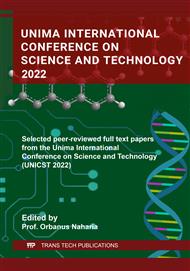[1]
Taunaumang H., Herman, M.O. Tjia (2001), Molecular Orientation in Disperse Red 1 Thin Film Produed by PVD Method , Journal of Optical Materials18 (2001) 343.
DOI: 10.1016/s0925-3467(01)00169-0
Google Scholar
[2]
Taunaumang, H., Hidayat R, Herman et al, Effects of substrate temperature and external poling field on molecular orientation and aggregation in vaccum deposited photoresponsive DR 1 films Journal of Nonlinear Optica Physics & Materials 12 (2) 213-219 Jan 2003.
DOI: 10.1142/s0218863503001341
Google Scholar
[3]
Arvidas Tamulis, Jalena Tamuliene, Mindaugas Leonas Balevicius , Jean-Michel Nunci, Quantum Chemical, Investigation of Disperse Orange 3 Molecule Cis-Trans Isomerization Through Linear Trnasition State and Design of Molecular Mechines, Proc. SPIE Vol. 4087.
DOI: 10.1117/12.406467
Google Scholar
[4]
Yang Wu, Jun Ho Cha Hyun Kwan Shim, Hyo Jin Seo, Sun Il Kim, Determination of photoisomerization parameters for a PMMA thin film doped with disperse orange 3, Optical Materials Volume 73, November 2017, Pages 680-685
DOI: 10.1016/j.optmat.2017.09.027
Google Scholar
[5]
Keiko Tawa, Koji Ohta, Azo-dye-structure dependence of photoinduced anisotropy observed in PMMA films, Journal of Photochemistry and Photobiology A: Chemistry, Volume 134, Issue 3, 14 June 2000, Pages 185-191.
DOI: 10.1016/s1010-6030(00)00268-9
Google Scholar
[6]
Wu, Yang; Cha, Jun Ho; Shim, Hyun Kwan; Seo, Hyo Jin; Kim, Sun Il , Determination of photoisomerization parameters for a PMMA thin film doped with disperse orange 3
DOI: 10.1016/j.optmat.2017.09.027
Google Scholar
[7]
Jaana Vapaavuori, Ville Valtavirta, Tapani Alasaarela, Jun-Ichi Mamiya, Cari Priimagi, ac Atsushi Shishidoc and Matti Kaivolaa, Efficient surface structuring and photoalignment of supramolecular polymer– azobenzene complexes through rational chromophore design, Journal of Materials Chemistry, 2011, 21, 15437-15441
DOI: 10.1039/c1jm12642c
Google Scholar
[8]
Alkin P.W (1963), Molecular Quantum Mechanics, Second Edition, Oxford University Press, New York, 319-345.
Google Scholar
[9]
Rochon, P., J. Gosselin, A. Natanshon and S. Xie. (1992), Optically induced and erased birefringence and dichroism in azoaromatic polymers, Appl. Phys. Lett. 60, 4-5.
DOI: 10.1063/1.107369
Google Scholar
[10]
Silverstein R.W., G.C. Bassler. (1967)., Spectrometer Identificationo, Organic Compounds, Second Edition , John Willey& Sons, INC. US, 148-169.
Google Scholar
[11]
Colthup, N.B., L.H. Daly , S.E. Wiberly, (1975), Introduction to Infrared and Raman Spectroscopy, Academic Press, London.
Google Scholar
[12]
Fei Dou, Jiawei Li, HUijie Men, and Xinping Zhang, Controlling Molecule Aggregation and Electronic Spatial Coherence in the H- Aggregate and J-Aggregate Regim at Room Temperature, Polymers 2020, 12, 786;.
DOI: 10.3390/polym12040786
Google Scholar
[13]
Frank Würthner, Dr. Theo E. Kaiser, Chantu R. Saha‐Möller, J‐ Aggregates: From Serendipitous Discovery to Supramolecular Engineering of Functional Dye Materials, 25 March 2011
DOI: 10.1002/anie.201002307
Google Scholar
[14]
Arri Priimagi, Andriy Shevchenko, M. Kaivola, Paul Rochon, High and stable photoinduced anisotropy in guest–host polymer mediated by chromophore aggregation, May 2010, Optics Letters 35(11): 1813-5.
DOI: 10.1364/OL.35.001813
Google Scholar


